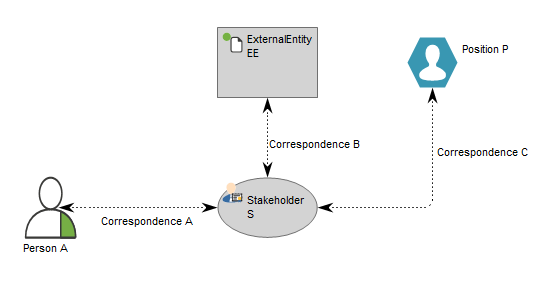Description of this template will be available soon.
Template Type: Connectors
Data Apply
Description of this template will be available soon.
Correspondence
The connection Correspondence is used to show relationship between a stakeholder object and a organizational object (Organizational unit, Person, Position, Role, InterestGroup, ExternalEntity) in a diagram (e.g. organizational diagram or Stakeholder Model).

Conversation Link
Conversation link refers to the relationship and communication between different participants or components within a larger system. It represents the exchange of messages or information between different participants or components, such as a system and a user, or two different systems.
For example, in a system where a user interacts with a chatbot to obtain customer support, the conversation link might be illustrated through a line connecting the user and the chatbot to represent the conversation between them. The conversation link might then continue with a line connecting the chatbot and the customer support system to represent the resolution of the user’s issue.
Connector
Description of this template will be available soon.
CauseEffect
In a cause and effect relationship, an action or event (which is the cause) produces an outcome or result (which is the effect).

Business Interaction
Business interaction refers to the relationships and interactions between different entities or stakeholders within a larger ecosystem. A business ecosystem is a complex network of organizations, individuals, and other entities that interact with each other in order to create, distribute, and consume products and services.
lines may be used to show the relationships and interactions between these components. For example, a line might connect a customer with a supplier to represent the flow of goods or services between the two entities. Similarly, a line might connect a partner with a competitor to represent a strategic alliance or collaboration between the two parties.
Authority Requirement DMN
Authority Requirement in DMN (Decision Model and Notation) refers to the concept of specifying the authority or permission required to perform an action or decision in a business process. This can include the authorization required to access certain information or perform certain tasks, as well as the authorization required to make certain decisions.
For example, a line might connect a decision to a role or position to represent how the decision requires authorization from that role or position. Similarly, a line might connect a task to a role or position to represent how the task requires authorization from that role or position.
Assignment ArchiMate
The assignment relationship expresses the allocation of responsibility, performance of behavior, or execution.
The assignment relationship links active structure elements with units of behavior that are performed by them, business actors with business roles that are fulfilled by them, and nodes with technology objects. It can, for example, relate an internal active structure element with an internal behavior element, an interface with a service, or a node with a technology object.

The usual interpretation of an assignment relationship is that the whole or part of the source element is assigned the whole of the target element. This means that if, for example, two active structure elements are assigned to the same behavior element, either of them can perform the complete behavior. If both active structure elements are needed to perform the behavior, the grouping element or a junction can be used, and if the combination of these elements has a more substantive and independent character, a collaboration would be the right way to express this.
Properties
The Assignment tab
| Property | Metamodel name | Description |
| Display name | DisplayName | Initial value is off. |
| Short description | ShortDescription | |
| Implements | Implements | Links to: All templates. |
| BreaksDownTo | BreaksDownTo | Links to: All templates. |
Assembly Flow
The Assembly flow is a connector used in the Manufacturing Routing Network diagram to connect WorkOperations, Products, BusinessObjects and ProductionLines to illustrate the assembly of products.
